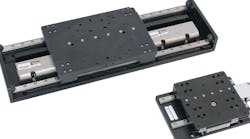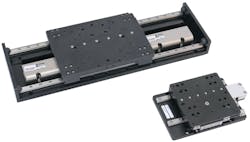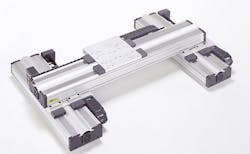Infrequently Asked Questions About Linear Actuators
Designers getting ready to choose a linear actuator for a specific device or machine should have a list of questions ready to ask suppliers and manufacturers of those devices. These lists usually contain FAQs (frequently asked questions), and most firms that sell actuators are prepared for them. But those suppliers, in many instances, expect potential buyers to ask other, perhaps more probing and revealing questions: the so-called infrequently asked questions (iFAQs).
Here are a pair of questions engineers should ask when considering specifying linear actuators.
Q. I need speed and accuracy over a long length. What type of actuator should I use?
A. That’s a smart question to ask. Many design engineers overestimate how accurate traditional motors and actuators are over long travel runs. They mistakenly believe that if the actuator works well for short runs, it will work equally well on long ones. Although many types of linear systems meet two of the three requirements engineers typically want (long travel lengths, high speed, and high positioning accuracy), linear motor actuators are the only ones that provide all three without compromise. They are often used in semiconductor manufacturing, consumer electronics inspection, medical and life science applications, machine tools, printing, and packaging applications.
To provide a little background, let’s define linear motors. Essentially, a linear motor is a rotary motor that has been unwound and laid out flat. It lets the motor couple directly to the linear load. In contrast, other designs use a rotary motor and couple it through mechanics, which can introduce backlash, efficiency losses, and other inaccuracies. Linear motors also tend to have higher maximum velocities compared to ball screws of the same travel length.
Three main types of linear motors are used today. The first is ironcore, which has coils wound around teeth made of ferrous materials and wrapped in laminate. These motors have the highest force per size and good heat transfer, and are generally the least expensive. However, iron in the motor leads to increased cogging (torque due to interactions between the motor’s magnets), so they are often somewhat less precise than the second type, ironless linear motors.
As the name implies, ironless linear motors don’t have any iron inside. The forcer is essentially an epoxy plate in which tightly wounded copper coils have been inserted. It slides between two rows of magnets facing each other. (This is also known as a U-channel magnetic way.) A spacer bar down one side of the magnets links them together. The main advantages of ironless motors are lower attractive forces and no cogging. This makes them more precise than ironcore motors. However, two rows of magnets make ironless units more expensive than ironcore versions. Managing heat transfer can also be difficult, so it’s important to understand early whether a particular application will run the risk of overheating. The newest ironless motors feature overlapped coils that provide more surface contact for heat dissipation. This design also lets the motor have a higher force density.
Modular ironless linear motor stages, such as the mSR100 (the larger actuator), offer various base sizes, travel lengths, and motor sizes to accommodate large applications. Ironcore linear motor stage, such as the mSR 80 (the smaller actuator) from Parker, combine a high level of force with a small footprint and highly precise movement thanks to a patented anti-cogging design.
The third and final type are slotless linear motors, which are basically hybrids of the first two types. A slotless motor has a single row of magnets like the ironcore, which helps keep its price lower. A laminated backiron ensures good heat transfer, as well as lower attractive forces and cogging than ironcore motors. Slotless motors also offer the advantage of a lower height profile than ironless in addition to their lower price. For designers who prioritize keeping components in their machines as small as possible, every millimeter of space saved can be crucial.
A growing number of slotless linear motor stages are designed to take on rugged applications that would normally require ironcore motors, combining higher force with the precision of an ironless motor. They combine high acceleration, high velocity, and quick settling, with accurate, highly repeatable positioning.
Q. How can I know if a given actuator is suitable for use in a specific environment?
A. All too often, design engineers choose actuators in isolation and don’t consider where they will be used. Linear actuators have critical moving parts that only work properly within environments for which they were designed and manufactured. Using an inappropriate linear actuator can cause problems ranging from improper operation to irreparable damage to the actuator itself. For “dirty” applications, such as a cutting tool that throws off particles and scrap, the actuator will require sealing and shielding to protect it from contaminants.
From the opposite perspective, an actuator without the proper protection can introduce contamination into a clean environment, compromising the application. Normal wear and tear will cause linear stages to generate particulates over time. Cleanrooms or vacuum environments are often restricted to using equipment that doesn’t release any particulates, so it is critical for actuators used in these environments that they are equipped with seals and shields to prevent particulates from entering the environment. Some mechanical devices that provide linear motion, such as in semiconductor processing, move only microns at a time, so even the least amount of contamination can compromise and ruin an application.
Seals and shields protect critical components from exposure to harsh environments, letting linear actuators run as they were designed to perform. For clean environments, seals and shields protect the application’s environment from possible contaminants created by the actuator—not the actuator itself. In addition to seals and shields, custom linear actuators can be designed with positive pressure ports that purge contaminants inside the unit, keeping the performance and life cycle at a maximum.
A variety of environmental factors must be considered when choosing linear actuators. These include ambient temperatures, the presence of moisture, exposure to chemicals and gasses (other than room air), radiation, the level of air pressure (for applications that are performed in vacuum), cleanliness, and nearby equipment. For example, is there a piece of equipment in the vicinity that could transfer vibrations that would affect the linear stage’s performance?
A linear stage’s Ingress Protection (IP) rating, which is typically provided in its specifications, indicates whether it has the proper protection from specific environments. IP ratings are defined levels of the effectiveness of an enclosure’s seals against intrusion from foreign bodies (dust and dirt) and various levels of moisture.
Enclosure ratings takes the form of “IP-“ followed by two digits. The first digit indicates the degree of protection from moving parts and foreign bodies. The second digit identifies the level of protection against exposure to different levels of moisture (from drips to sprays to total submersion).
Here are explanations for the IP ratings (more information on IP ratings can be found in the ANSI/IEC 60529-2004 standard):
|
First Number |
Level of Protection Against Particles |
|
0 |
No protection |
|
1 |
Stops objects > 50 mm |
|
2 |
Stops objects > 12.5 mm |
|
3 |
Stops objects > 2.5 mm |
|
4 |
Stops objects > 1 mm |
|
5 |
Limited protection against dust |
|
6 |
Dustproof |
|
2nd Number |
Level or Protection Against Water |
|
0 |
No protection |
|
1 |
Dripping water / vertical |
|
2 |
Dripping water /up to 15 deg. angle |
|
3 |
Water spray |
|
4 |
Water splash |
|
5 |
Waterjet |
|
6 |
Powerful waterjet |
|
7 |
Temporary immersion |
|
8 |
Continuous immersion |
Taking the time to check an actuator’s IP rating early in the selection process offers a quick and easy way to eliminate units unsuitable for the environment. For example, an actuator with an IP30 rating offers no protection against moisture, but it will keep out finger-sized objects. If moisture protection is essential, look for an actuator with a higher rating, such as IP54, which protects dust and water splash. Actuators without intrusion or moisture protection, however, can offer economical alternatives for environments where contaminants are not a concern.




